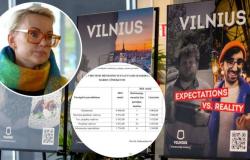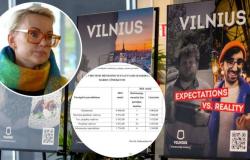Every year, as Easter approaches, we turn our heads about the festive menu – we want to surprise our loved ones not only with bright, strong marguets, delicious main dishes, but also to offer an interesting dessert. If you haven’t chosen one yet this year, chef and Maximos culinary ideas partner Gian Luca Demarco suggests taking ideas from his native Italy and serving Colomba to guests next to tea. This is a traditional, special cake, without which the Easter table in Italy would not be complete. According to the chef, this pastry is as important and necessary element of the holiday for Italians as printed eggs are for Lithuanians.
The word “Colomba” means “dove” in Italian, so it is not surprising that the typical shape of this cake usually resembles a bird with outstretched wings. It is said that giving such a name and shape to the baked goods is a kind of homage to this symbol of peace, widely associated with St. Easter.
In addition, this celebratory pastry has a really strong sacred meaning in Italy, and when served on Easter, it is often associated with wishing each other peace and tranquility.
The recipe is complex and not for everyone
According to famous chef Gian Luca, “Colomba” may remind some of the “Panettone” cake, considered a symbol of Christmas and well known to Lithuanians. However, as he himself claims, real cooks would never allow these two baked goods to be mixed or juxtaposed.
“The main similarity between the cakes is that they both take a long time to make. Traditional Colomba dough is aged for about 48 hours, but often this process can last much longer. For example, our family recipe requires it to be aged for at least 72 hours, and only natural yeast is used to make the dough.
In the production process of Colombo, it is also interesting that after baking the cake, it needs to cool by hanging upside down – then the texture becomes fluffy and light”, says the chef.
However, speaking, Gian Luca also adds that due to the complex production process, even the most meticulous bakers would rather buy this cake in the best bakery than prepare it at home. In addition, it is not necessary for the residents of our country to dive out of their skin and spend so much time on the production of “Colombo” in order to taste it.
“Before the big holidays, we purposefully expand the assortment so that everyone can find both their favorite traditional products and innovations. This year, our customers can taste the Colomba cakes brought directly from Italy and choose from 7 different types of this famous Italian culinary masterpiece, which can be taken care of for less during the entire period of preparation for Easter. Currently, the assortment includes chocolate cream filling, peach pieces, traditional and even with Colomba flavored with limoncello cream. We hope that this cake will also find its place on the residents’ festive table and inspire new experiences, as it happened during the winter holidays with Panettone”, says Indrė Trakimaitė-Šeškuvienė, director of the Communication and Corporate Relations Department of Maxima.
At least a few festive cakes are on the Easter table
Gian Luca himself adds that the variety of Colomba flavors is not limited to a few versions. According to him, there can be as many versions of this cake as the masters themselves. In addition, if raisins are added to the traditional Panettone cake, then in the classic Colomba ” – candied fruit.
“Traditional Colomba is vanilla, candied orange and topped with the absolutely necessary sweet hazelnut and almond frosting, flavored with crunchy almonds. Today, however, the cake comes in all sorts of variations: with cherries, peaches, oranges, raisins, pistachios, chocolate, salted caramel, etc. Of course, the flavor characteristics of the baked goods are determined by the region and customs, but you will never ask for just the classic version of Colombo,” advises Gian Luca.
By the way, the chef admits that a typical Easter in Italy is never celebrated with just one “Colomba”, because this pastry is usually brought to guests during the holiday, and given to relatives.
“After the holiday, all Italians have at least five Colombos at home, so they are enjoyed almost until summer. The good news is that this pastry does not spoil for long if you keep it tightly covered. However, after a while Colombos for breakfast, lunch and dinner ends up being mission impossible,” he jokes.
He told us the difference between Lithuanian and Italian Easter
The Italian, who has been living in Lithuania for sixteen years, also admits that Lithuanian Easter traditions are very different from his homeland, but over time he not only began to like Lithuanian holiday customs, but also pushed him to discover new traditions.
“I find the Lithuanian tradition of celebrating Margučius very beautiful. In our country, eggs do not have any meaning during Easter – we neither paint them nor take them to church. In the best case, we stuff it with all kinds of spices and eat it. In Lithuania, I have been used to consecrating eggs for many years, so I always try to follow this ritual honestly,” shares Gian Luca.
The chef notices more differences between the celebration of Easter in Lithuania and Italy. According to him, the main festive dish in Italy, known as the pearl of the Mediterranean Sea, is always lamb.
“While celebrating my first Easter in Lithuania, I was surprised not to find lamb on the festive table. You won’t believe it, but after the holiday lunch, I rushed to the store, bought a small piece of it and personally baked it for myself. Since then, every year I try to cook lamb not only for myself, but also for the whole family,” says the chef who tries to combine different traditions.
By the way, living in Lithuania and raising three children here, Gian Luca admits that he does not shy away from trying games with his children during Easter.
“I like both looking for the strongest egg and rolling the checkers. These activities enliven the entire celebration. In Italy, most people just eat, eat and eat during Easter. Of course, it is important to get together, to be with family, and after all, food in Italy brings relatives and friends together – it is part of our culture. But in Lithuania, Easter is also a big and highly anticipated holiday for me,” says Gian Luca.






